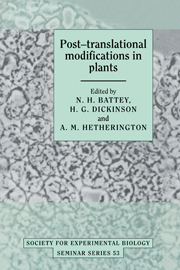Book contents
- Frontmatter
- Contents
- List of contributors
- List of abbreviations
- Preface
- Some roles of post-translational modifications in plants
- Signal transduction and protein phosphorylation in bacteria
- Roles of protein phosphorylation in animal cells
- The significance of post-translational modification of proteins by phosphorylation in the regulation of plant development and metabolism
- Post-translational modification of chloroplast proteins and the regulation of protein turnover
- Purification of a small phosphoprotein from chloroplasts and characterisation of its phosphoryl group
- Use of synthetic peptides to study G proteins and protein kinases within plant cells
- Activation of membrane-associated protein kinase by lipids, its substrates, and its function in signal transduction
- Distribution and function of Ca2+-dependent, calmodulin-independent protein kinases
- Phosphorylation of the plasma membrane proton pump
- The regulation of phosphoenolpyruvate carboxylase by reversible phosphorylation
- Protein phosphorylation and circadian rhythms
- Control of translation by phosphorylation of mRNP proteins in Fucus and Xenopus
- Regulation of plant metabolism by reversible protein (serine/threonine) phosphorylation
- Detection, biosynthesis and some functions of glycans N-linked to plant secreted proteins
- Biosynthesis, intracellular transport and processing of ricin
- Post-translational processing of concanavalin A
- The role of cell surface glycoproteins in differentiation and morphogenesis
- Ubiquitination of proteins during floral development and senescence
- Index
Post-translational modification of chloroplast proteins and the regulation of protein turnover
Published online by Cambridge University Press: 06 July 2010
- Frontmatter
- Contents
- List of contributors
- List of abbreviations
- Preface
- Some roles of post-translational modifications in plants
- Signal transduction and protein phosphorylation in bacteria
- Roles of protein phosphorylation in animal cells
- The significance of post-translational modification of proteins by phosphorylation in the regulation of plant development and metabolism
- Post-translational modification of chloroplast proteins and the regulation of protein turnover
- Purification of a small phosphoprotein from chloroplasts and characterisation of its phosphoryl group
- Use of synthetic peptides to study G proteins and protein kinases within plant cells
- Activation of membrane-associated protein kinase by lipids, its substrates, and its function in signal transduction
- Distribution and function of Ca2+-dependent, calmodulin-independent protein kinases
- Phosphorylation of the plasma membrane proton pump
- The regulation of phosphoenolpyruvate carboxylase by reversible phosphorylation
- Protein phosphorylation and circadian rhythms
- Control of translation by phosphorylation of mRNP proteins in Fucus and Xenopus
- Regulation of plant metabolism by reversible protein (serine/threonine) phosphorylation
- Detection, biosynthesis and some functions of glycans N-linked to plant secreted proteins
- Biosynthesis, intracellular transport and processing of ricin
- Post-translational processing of concanavalin A
- The role of cell surface glycoproteins in differentiation and morphogenesis
- Ubiquitination of proteins during floral development and senescence
- Index
Summary
Our efforts are centred around the regulatory mechanisms controlling the assembly, function and turnover of the photosystem II (PSII) reaction centre. The PSII reaction centre consists of D1, D2, the α and β subunits of cytochrome b559 and the psbl gene product. Of these proteins, the metabolism of the D1 protein is relatively well understood. Because D1 is synthesised and rapidly degraded in the light, it is well suited for in vivo pulse–chase analysis. The D1 protein undergoes at least five post-translational modifications during its life cycle: C-terminal processing, removal of the initiating methionine residue, N-acetylation of the resulting N-terminal threonine residue, covalent palmitoylation, and O-phosphorylation of the N-terminal threonine of the mature protein. Processing of D1 occurs on stroma-exposed membranes while palmitoylation and phosphorylation occur in spatially distinct grana membranes. The palmitoylation is light-stimulated, inhibited by the herbicides atrazine and DCMU, and is apparently transient in nature. This modification might be important in the assembly of the protein in the PSII reaction centre and/or in its translocation from stroma membranes to grana. D1 phosphorylation increases with increasing light intensity, is inhibited by atrazine and DCMU and is redox regulated in vitro. In vivo, phosphorylated D1 undergoes light-dependent turnover as a function of light intensity; this process occurs under blue, green, and red illuminations and is inhibited by sodium fluoride but not by the PSII herbicides. We are investigating the role of phosphorylation–dephosphorylation in the function and dynamics of PSII.
- Type
- Chapter
- Information
- Post-translational Modifications in Plants , pp. 65 - 78Publisher: Cambridge University PressPrint publication year: 1993
- 5
- Cited by

